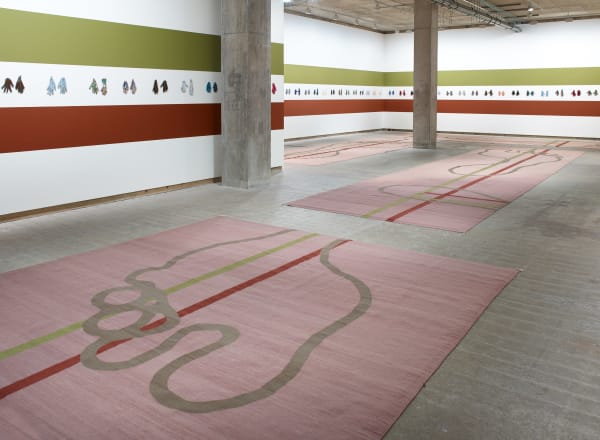Polly Apfelbaum: Dubuffet's Feet My Hands
This exhibition of work by Polly Apfelbaum is the latest in a series of installations that incorporate hand-woven carpets, ceramics, and immersive colour. Each one is structured around thematic references: art-historical, place, or popular culture. These installations work simultaneously with architecture, colour, and form; they encourage the viewer to actively engage with the work in space. Curator Kate McNamara has noted that carpets are the logical conclusion of Apfelbaum’s longstanding engagement with the floor, with pliable supports, fabric and decorative art traditions:
'Rugs are site-specific; they have decorated castle floors, buried Siberian royalty and lined suburban staircases. Many rugs are designed to tell stories through patterns and woven symbols passed down for generations. For Apfelbaum, the material, function, and format of the rug has come to represent a culmination of her artistic practice.'
For this installation, Apfelbaum worked with weavers in Oaxaca, Mexico, where the Zapotec people have been weaving textiles for over 2,000 years. Entitled Dubuffet's Feet, this floor work is based on a small drawing titled Footprints in the Sand by Jean Dubuffet from his 1948 sketchbook El Golea II, which the artist saw at the Museum of Modern Art, New York. Apfelbaum has translated the image into a series of hand-woven rugs, each depicting an enormous footprint of a figure who would be over 100 feet tall. There are four carpets, two with left feet and two with right, aligned as parallel pairs, implying the trace of two giants. While Apfelbaum's carpets are woven in earth tones that may evoke the 1970s, they also correspond with the sand in which Dubuffet's footprints may have been left, and thus the natural landscape. Enlarged far beyond human scale, Apfelbaum's imprints monumentalise an intentional awkwardness. The parallel series My Hands has evolved from Apfelbaum’s ongoing experiments with glazed ceramics. They take their inspiration from the 'floating hand of God' in the mosaics of the basilica of Sant’Apollinare Nuovo in Ravenna, which she visited during a residency at the American Academy in Rome in 2013. Apfelbaum was fascinated by this image of the disembodied hand as the symbol of creation and intervention. Apfelbaum has used her own hand as a template for these works, creating a relationship to the artist’s touch while also dealing with ideas about craft and making, from prehistoric times to children’s pre-school handprints. They invoke Portuguese author José Saramago’s celebration of the intelligence of the hand:
'The brain-in-the-head has always lagged behind the hands, and even now, when it seems to have overtaken them, the fingers still have to summarise for it the results of their tactile investigations, the shiver that runs across the epidermis when it touches clay, the lacerating sharpness of the graver, the acid biting into the plate, the faint vibration of a piece of paper laid flat, the orography of textures, the crosshatching of fibres, the alphabet of the world in relief.'
Polly Apfelbaum was born in 1955 in Abington, Philadelphia and has lived and worked in New York City since 1978. Recent exhibitions include: An Irruption of the Rainbow: Colour in 20th-Century Art, LACMA, Los Angeles (2017); Life is not black and white, L’art dans les Chapelles, Chapelle Saint Jean, Le Sourn, France (2017); Chromatic Scale: Prints by Polly Apfelbaum, National Museum of Women in the Arts, Washington DC (2017); Face (Geometry) (Naked) Eyes, Ben Maltz Gallery, Otis College of Art and Design, Los Angeles (2016), and Deep Purple, Red Shoes, Be-Part, Waregem, Belgium (2015). In 2018 Apfelbaum will have major solo exhibitions at Ikon Gallery, Birmingham and 21er Haus, The Belvedere, Vienna.
-
 POLLY APFELBAUMDubuffet’s Feet My Hands, 2016 - 20174 rugs; hand dyed hand woven wool, cotton
POLLY APFELBAUMDubuffet’s Feet My Hands, 2016 - 20174 rugs; hand dyed hand woven wool, cotton
100 pairs of ceramic hands; glaze on terracotta & porcelainRugs: 350.52 x 365.76 cm, 1036.32 x 259.08 cm, 731.5 x 243.8 cm, 777.24 x 243.8 cm
Hands: 29 x 21 x 1 cm (each pair, approx.) -
 POLLY APFELBAUMMy Hands, 4, 201721 x 25.5 x 1 cm
POLLY APFELBAUMMy Hands, 4, 201721 x 25.5 x 1 cm
8.3 x 10 x .4 in -
 POLLY APFELBAUMMy Hands, 5, 201722 x 28.5 x 1 cm
POLLY APFELBAUMMy Hands, 5, 201722 x 28.5 x 1 cm
8.7 x 11.2 x .4 in -
 POLLY APFELBAUMMy Hands, 10, 2017Glaze on terracotta21.7 x 26.5 x 1 cm
POLLY APFELBAUMMy Hands, 10, 2017Glaze on terracotta21.7 x 26.5 x 1 cm
8.5 x 10.4 x .4 in
-
 POLLY APFELBAUMMy Hands, 18, 2017Glaze on porcelain19.5 x 25.5 x 1 cm
POLLY APFELBAUMMy Hands, 18, 2017Glaze on porcelain19.5 x 25.5 x 1 cm
7.7 x 10 x .4 in -
 POLLY APFELBAUMMy Hands, 27, 2017Glaze on pink porcelain20.5 x 22.8 x 1 cm
POLLY APFELBAUMMy Hands, 27, 2017Glaze on pink porcelain20.5 x 22.8 x 1 cm
8.1 x 9 x .4 in -
 POLLY APFELBAUMMy Hands, 30, 201723.5 x 35.5 x 1 cm
POLLY APFELBAUMMy Hands, 30, 201723.5 x 35.5 x 1 cm
9.3 x 14 x .4 in -
 POLLY APFELBAUMMy Hands, 38, 2017Glaze on yellow porcelain19.8 x 24.5 x 1 cm
POLLY APFELBAUMMy Hands, 38, 2017Glaze on yellow porcelain19.8 x 24.5 x 1 cm
7.8 x 9.6 x .4 in










